There are many different species of catfish that thrive in an aquarium setting, but which ones are best suited for small aquariums, and how can you make sure they thrive?
Some of the best catfish for small aquariums include the Corydoras Catfish, which is ideal for smaller 10 gallon tanks. Other species of catfish like the Otocinclus Catfish and the Asian Stone Catfish are suitable for 20 gallon tanks.
There are a handful of different species of catfish that can live peacefully and comfortably in a small aquarium, but it’s important to understand which ones are right for you, since each species is different, and which ones shfould unequivocally never be put in a smaller tank.
Keep reading because I’m going to provide lots of helpful tables and information to help you find the best catfish for your small aquarium.
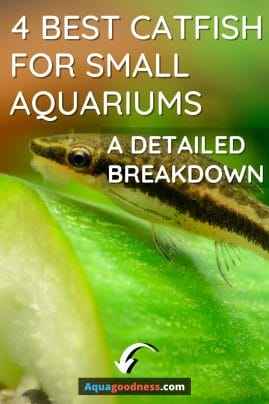
Table of Contents
The Single Best Catfish for Small Tanks
Hands down, the best catfish that you can include in almost any small tank is the Corydoras catfish.
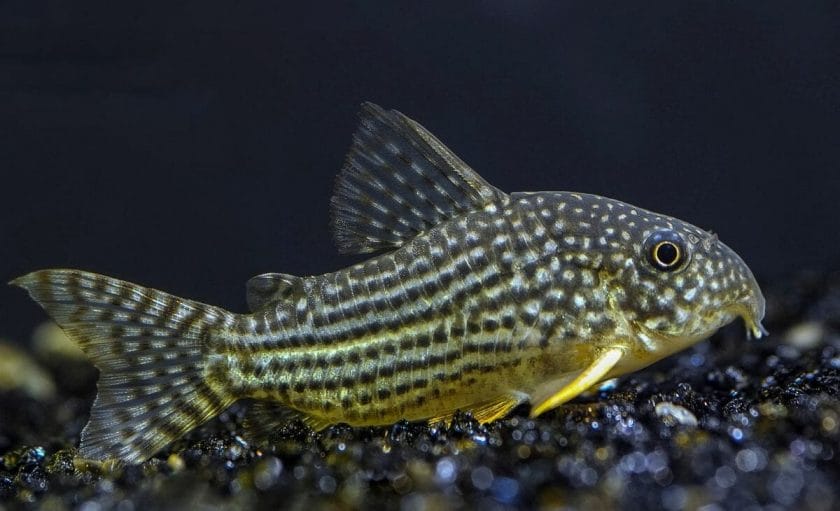
These popular fish have the qualities of an amazing community fish, and they come in a range of beautiful colors, with lots of different species having similar easy care requirements.
Whether you’re a beginner or an expert, the Corydoras catfish is the perfect starting point to include catfish in your small tank.
Here’s an extensive breakdown of exactly what Cories need to thrive in a tank environment:
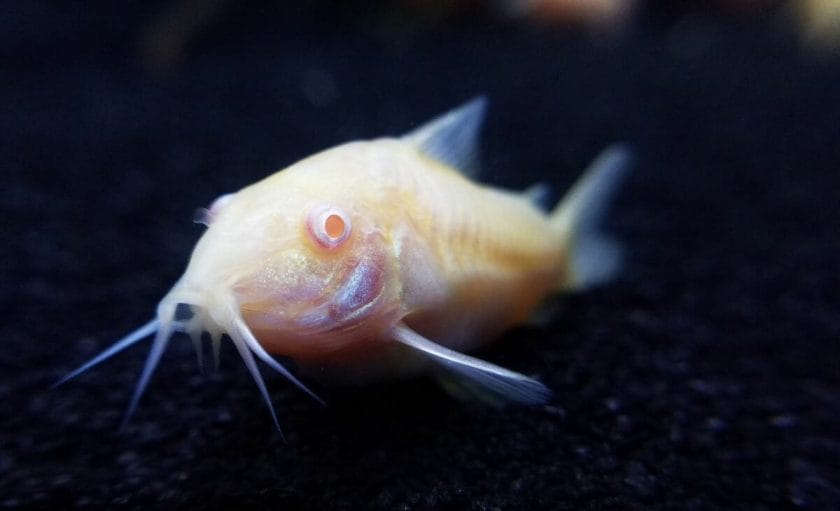
| Scientific Name | Corydoras paleatus |
| Common Names | Cory catfish, cory, corydora |
| Adult Size | 1 – 4 inches |
| Temperature Range | 70 – 82 F |
| pH | 6.0 – 8.0 |
| Minimum Tank Size | 10 gallons |
| Diet | Omnivorous |
| Colors | Black, white, brown |
| Temperament | Peaceful |
| Water Hardness | 5 – 10 dGH |
| Care Level | Very easy |
| Breeding Type | Egglayers |
| Substrate Preference | Sand, gravel (no sharp gravel) |
Cory catfish are very common in pet stores around the world. One of my favorite species is the panda cory for their beautiful black and white markings.
They dwell on the bottom and just tend to chill in the substrate most of the time. Because they spend a significant amount of time resting on the bottom, the only major important tank guideline is soft substrate like sand or gravel.
They are hardy, adaptable, and capable of surviving in varied tank conditions, which makes them a perfect addition to most community tanks.
In the wild, they prefer shallow waters with a slow-moving current. Plants, of course, help keep the environment feeling natural. I recommend Amazon Sword, penny wart, and crypts for beginners.
Caves are ideal for Cories (and other species of catfish) to help provide plenty of space to hide and make the fish feel safer in the tank environment. They are very peaceful and active, providing lots of movement in your tank without the hassle of a complex care schedule.
Some popular species of Cories include the following:
- Bandit Cory
- Panda Cory
- Julii Cory
- Pygmy Cory
- Albino Cory
- Dwarf Cory
- Sterba’s Cory
You can safely keep 2-4 cory catfish in a 10-gallon tank. Some species of cories (not those included above) require schools of 6+ fish to spread out aggression and create a natural schooling environment, so definitely keep that in mind while you shop to make sure you’re providing a suitable environment that accommodates your fish well.
Best Catfish for 10 Gallon Tanks
A 10-gallon tank provides a good amount of space to house a couple different species of catfish, although it’s important to recognize that you won’t be able to house most catfish species since they require a larger tank.
Some of the fish I would recommend that work well in a small tank environment (aside from the aforementioned Cories) such as a 10-gallon aquarium include the following:
- Otocinclus
- Asian Stone Catfish
Here’s a breakdown of each of these fish and their needs:
1. Otocinclus

| Scientific Name | Otocinclus spp. |
| Common Names | Otocinclus |
| Adult Size | 1 – 2 inches |
| Temperature Range | 72 – 78 F |
| pH | 6.0 – 7.5 |
| Minimum Tank Size | 10 gallons |
| Diet | Algae-based with lots of veggies |
| Colors | White with dark spots or brown line, species dependent. |
| Temperament | Generally peaceful |
| Water Hardness | 2 – 8 dGH |
| Care Level | Easy |
Originally from slow-flowing rivers in South America, the otocinclus brings a laid-back personality to almost any community tank environment with its strong mouth and rectangular body armored with plating.
They are shy, fast-swimming, and largely nocturnal, spending most of their time grazing on algae in groups at the bottom of the tank. As such, it’s important to school the otocinclus with others of its kind.
The otocinclus comes in a range of colors, but each species usually has very transparent fins. They can be speckled brown, gold, black-and-white, or mottled gray depending on the species.
They grow up to 2 inches, although the females tend to be larger than the males. When cared for properly, they can live for 3 – 5 years in captivity.
2. Asian Stone Catfish
| Scientific Name | Hara jerdoni |
| Common Names | Dwarf Anchor Catfish, Sylhet Hra |
| Adult Size | 1-2 inches |
| Temperature Range | 64 – 75 F |
| pH | 5.6 – 7.6 |
| Minimum Tank Size | 5 gallons |
| Diet | Omnivorous |
| Temperament | Peaceful, Timid |
| Water Hardness | 8 – 15 dGH |
| Care Level | Easy |
The Asian Stone Catfish is a sedentary bottom feeder that gets along well with other peaceful species of fish, making them a great pick for beginner aquarists.
Hailing from slow-moving streams in northern India and Bangladesh, these subtle fish are rarely seen in a tank because they prefer to stay hidden.
However, they are a rare sight to see, with mottled brown and gray coloring and striped patterns across their skin. They can live up to 5 years with proper care. More Asian Stone Catfish help to make the environment feel safer, which is why you should ideally house these fish in a group of 6 or more.
Both of these species are ideal for 10-gallon tanks because they are peaceful, timid, and capable of withstanding a range of tank conditions. As such, they add a beautiful splash of color without adding too much to your workload.
The ideal candidate for a 10-gallon tank is a catfish that is amenable to tankmates, keeps to itself, and is capable of withstanding a range of tank conditions.
The Otocinclus and Asian Stone Catfish both hit the mark, making them a great option if you want to fill some floor space in your 10-gallon tank.
Best Catfish for 20 Gallon Tanks
If you’ve got a little bit more room in a 20-gallon tank, then your best bet is the clown pleco. You can, of course, include the Asian Stone Catfish, the Otocinclus, or Cories in a 20-gallon tank quite comfortably.
Clown Pleco

| Scientific Name | Panaque maccus |
| Common Names | Clown Pleco |
| Adult Size | 3 – 3.5 inches |
| Temperature Range | 72 – 82 F |
| pH | 6.8 – 7.6 |
| Minimum Tank Size | 20 gallons |
| Diet | Omnivorous, with plenty of vegetable matter |
| Colors | Dark brown, black, with red, yellow, white, orange, or gold coloration |
| Temperament | Territorial |
| Water Hardness | Soft to medium |
| Care Level | Very easy |
There aren’t really any other species of pleco that are appropriate to house in a 20-gallon tank. Most need at least 30 gallons or more, and their high bioload makes them a liability–both to themselves and to their tankmates–in a tank that’s too small.
Clown plecos are the rare exception, although you should certainly be careful how you stock a tank when you include clown plecos in your 20 gallon, since this is the absolute minimum they can thrive in.
Clown plecos reach full size after 2 years and boast a range of beautiful color patterns. Most often, Clown plecos manifest brown or tan coloring with black or brown stripes. They can, however, take on green, orange, or even blue colors with striking fin patterns.
As most plecos are, Clown plecos are pretty laid-back, although as catfish, they can be somewhat territorial.
That’s not generally an issue since they’re nocturnal and won’t tend to pick on anything above floor level. For best care, give them plenty of hiding places and pair them with other peaceful fish.
They are notoriously difficult to breed, so don’t expect anything, especially as a beginner aquarist. With that being said, they do well in groups of three and are a perfect addition to a 20 gallon tank, as long as you’re careful not to overstock the tank.
What Is the Minimum Tank Size for Catfish?
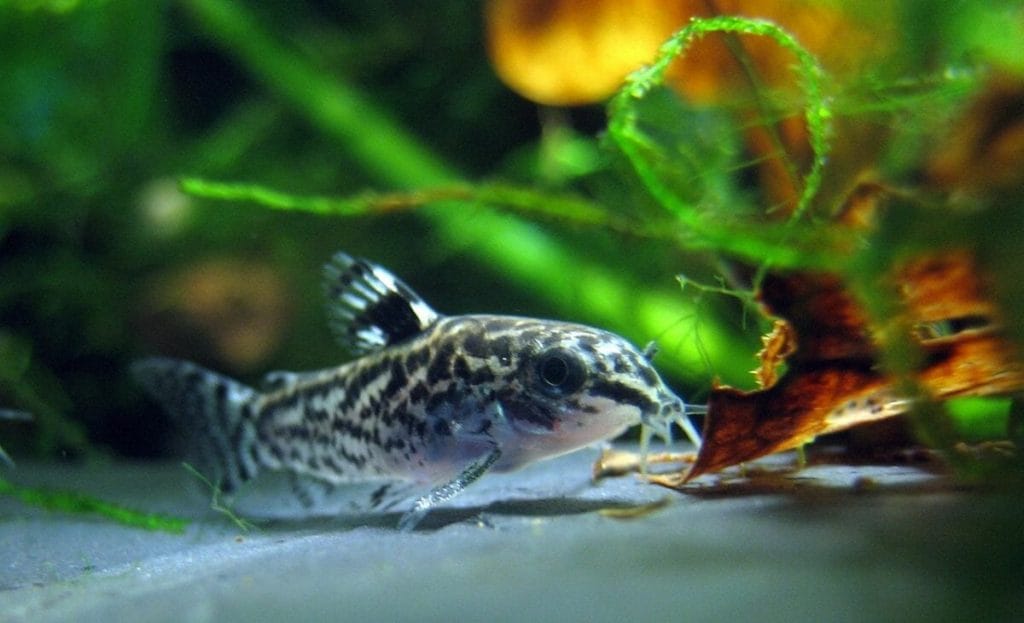
Tank size is an important factor for most species of catfish, since their growth and health are largely determined by the tank size.
If the tank isn’t big enough to accommodate their growth, catfish can be stunted and harmed by poor water conditions, shortening their lifespan and making their life as a whole miserable.
Most species of catfish need at least 30 gallons of space, and the minimum tank size depends on the species of catfish. For even the smallest catfish, 10 gallons is the absolute lower threshold you shouldn’t cross.
Stock your tank accordingly, paying close attention to the recommended tank size and school size we’ve provided to find a sensible balance of school size and fish size.
The one-inch-per-2-gallons rule is a good general guideline to go by to determine whether a fish is suited for your tank size.
Most catfish, unfortunately, grow too big to be comfortably housed in a 10 or 20 gallon tank, with a few notable exceptions. That concern is especially prevalent in schooling catfish that need groups of 3-4 to be happy.
The Cory is a happy exception, living comfortably in 10-20 gallon tanks (when properly stocked), and there are a number of different species to consider.
FAQs
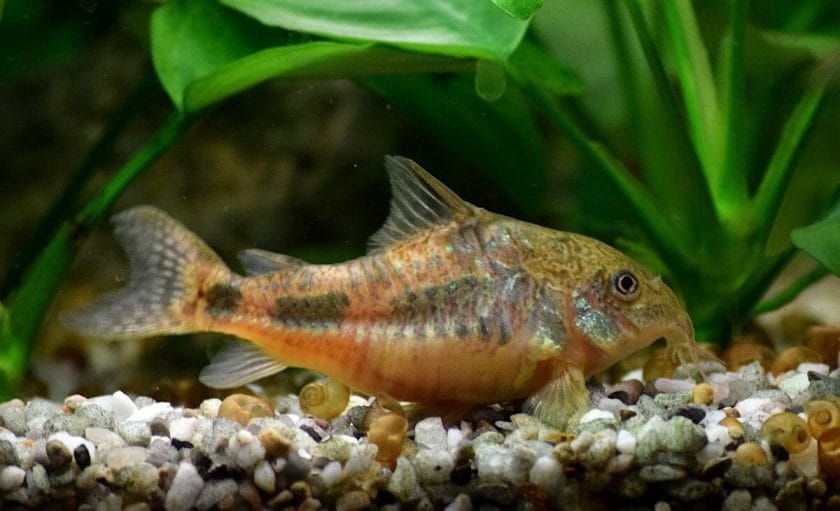
Are Catfish Necessary in an Aquarium?
Catfish are not necessary to clean an aquarium, but they do provide good floor movement and some (like plecos) can play a role in keeping your glass and decorations clear of algae, although they cannot solely handle an algae bloom.
What Is the Smallest Aquarium Catfish You Can Get?
The Asian Stone Catfish, measuring 1.3 inches on average at full size, is one of the smallest aquarium catfish species you can get, being perfectly comfortable in 10-gallon spaces.
Conclusion
There are a number of different catfish species that can add life and vibrancy to your tank floor, but it’s important to always consider their well-being, too.
Some species of catfish need more room than you might think, so it’s important to do your research and stock your tank accordingly.
Make sure you refer to the helpful lists and table above if you need some reference for the best catfish species I recommend for your smaller aquariums.